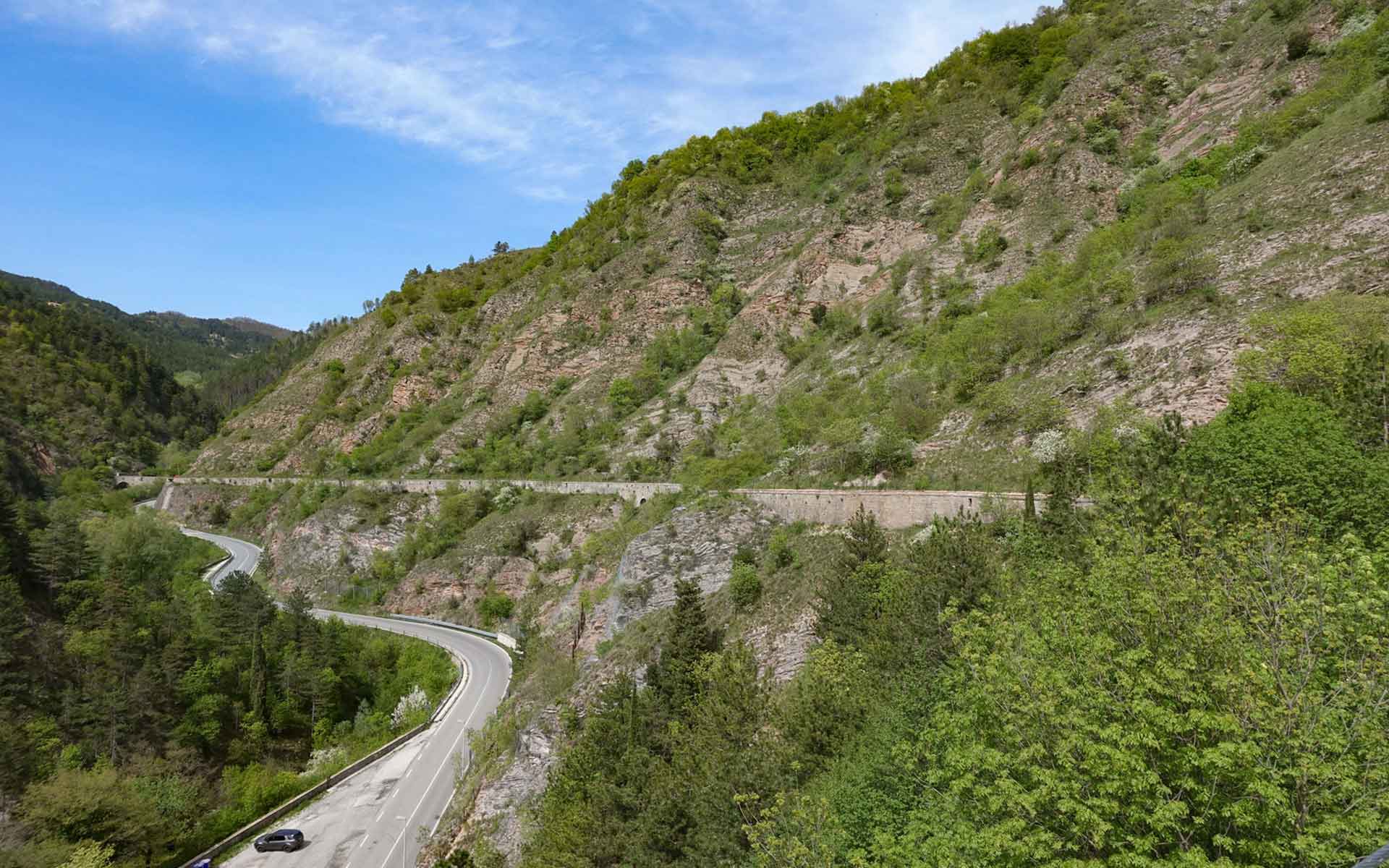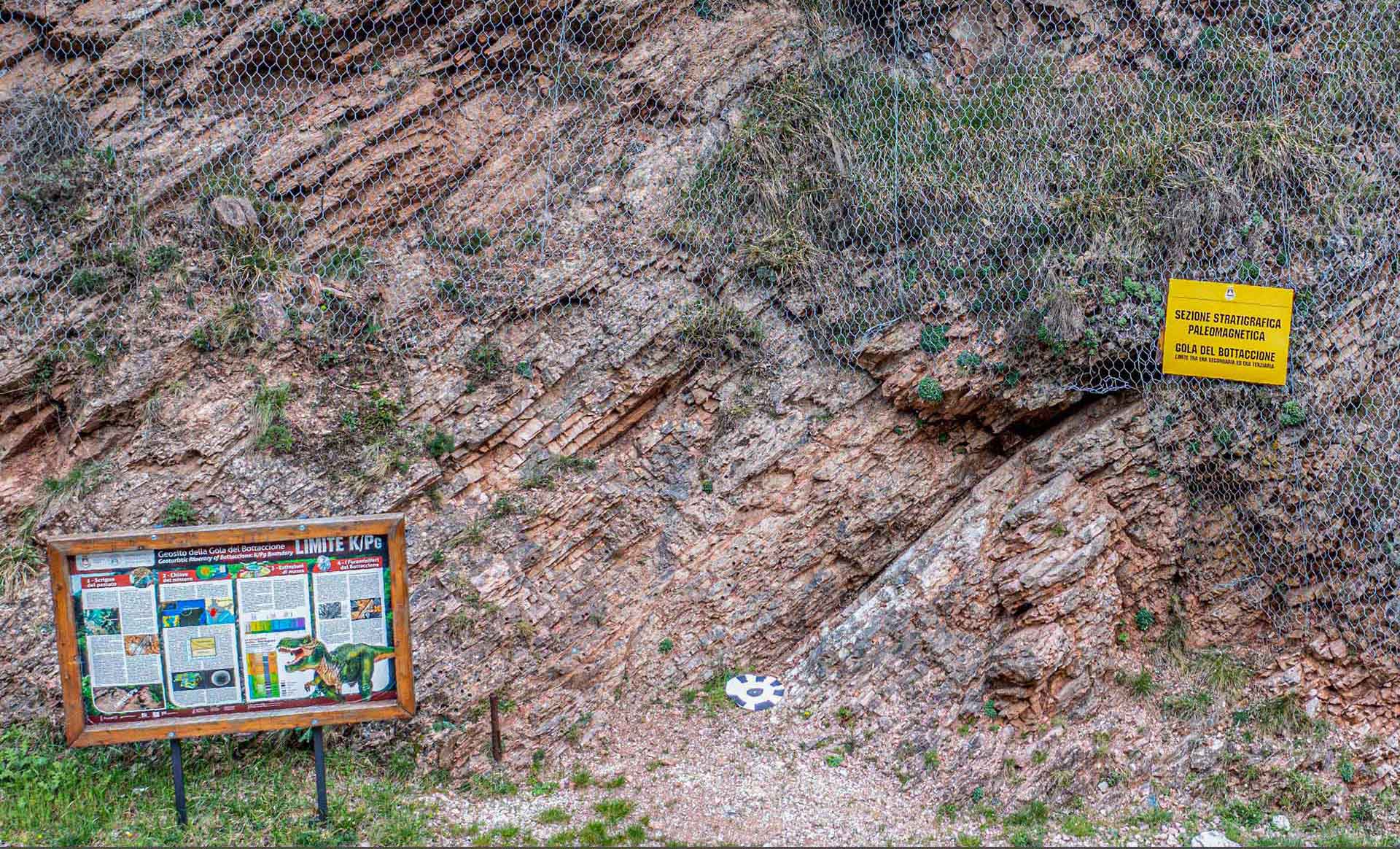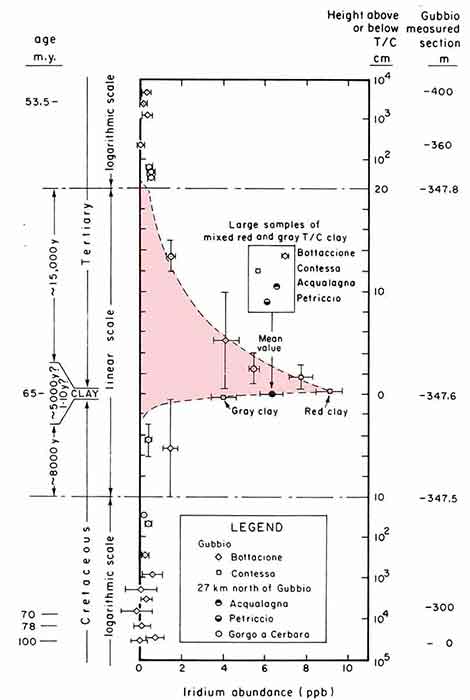Cretaceous to Paleogene stratigraphic section of Bottaccione Gorge, Gubbio
ITALY

Upper part of the Bottaccione Gorge section, showing the Campanian and Maastrichtian part of the section. A medieval aqueduct is also seen. (Photo by Birger Schmitz).
Geological Period
Cretaceous – Paleogene
Main geological interest
Stratigraphy and sedimentology
History of geosciences
Location
Umbria, Italy.
43°21’55.0″N, 12°34’57.0″E
Upper part of the Bottaccione Gorge section, showing the Campanian and Maastrichtian part of the section. A medieval aqueduct is also seen. (Photo by Birger Schmitz).
One of the most complete Cretaceous to Paleogene pelagic limestone sections known, and where the K-Pg iridium anomaly was first found.
The section is a global reference succession for bio-and magnetostratigraphy across the Cretaceous and Paleogene, including the K-Pg boundary. Here pelagic limestones were first dated with foraminifera in thin section, long-section magnetic polarity-reversal stratigraphy was first established, and the K-Pg iridium anomaly first detected. Reconstructions have also been made of Earth’s orbital cycles and variations in flux of extraterrestrial matter from different regions of the solar system. Every year the section is visited by hundreds of geologists. Many students learn here the basics of reading Earth’s history from its stratigraphic record.
- Geological description
The Bottaccione Gorge at Gubbio was the first major outcrop of pelagic limestone ever studied. Here the identification of planktonic foraminifera in thin section was first applied to hard rocks from which isolated foraminifera could not be extracted (Renz, 1936; Luterbacher and Premoli Silva, 1962). Anomalous levels of iridium were first reported from the K-Pg boundary at this and nearby localities (Alvarez et al., 1980). Iridium is present in meteorites but essentially absent in Earth’s sediments, which led to the theory that a large comet or asteroid impacted the Earth, triggering the K-Pg mass extinction. This theory was later confirmed by the discovery of the 150-km diameter Chicxulub structure in the subsurface of the Yucatán Peninsula of Mexico, the largest impact crater known from the last billion years of Earth history. Magnetic polarity reversal stratigraphy of limestones was first done in the Bottaccione Gorge, with the foraminiferal biostratigraphy making possible the dating of the magnetic polarity stripes on the ocean floor, and in turn the dating of the opening of the Atlantic Ocean by sea-floor spreading (Lowrie and Alvarez, 1981). Lately, a high-resolution cyclostratigraphic framework has been established at the section. For a review see e.g., Galeotti et al. (2015).
- Scientific research and tradition
The section has been the subject of scientific research since the pioneering work of Renz in 1936. During the ‘60s and ‘70s, the analysis of the section contributed to an integration of bio- and magnetostratigraphy. The section is visited by hundreds of geologists from all over the world every year.
The iridium profile across the Cretaceous-Paleogene boundary from samples collected in several Scaglia Rossa sections throughout the Umbria-Marche basin, as reproduced from fig. 5 in Alvarez et al. (1980). Note the linear scale (in cm) in the 15 cm interval bracketing the boundary interval (from Montanari and Coccioni, 2019).
- Reference
Alvarez, L.W. et al. (1980) ‘Extraterrestrial cause for the cretaceous-tertiary extinction’, Science, 208(4448), pp. 1095–1108. Available at: https://doi.org/10.1126/science.208.4448.1095.
Galeotti, S. et al. (2015) ‘The Bottaccione section at Gubbio, central Italy: a classical Paleocene Tethyan setting revisited’, Newsletters on Stratigraphy, pp. 325–339. Available at: https://doi.org/10.1127/nos/2015/0067.
Lowrie, W. and Alvarez, W. (1981) ‘One hundred million years of geomagnetic polarity history’, Geology, 9(9), pp. 392–397. Available at: https://doi.org/10.1130/0091-7613(1981)9<392:OHMYOG>2.0.CO;2.
Luterbacher, H.P. and Premoli Silva, I. (1962) ‘Note préliminaire sur une revision du profil de Gubbio, Italie’, Rivista Italiana di Paleontologia e Stratigrafia, 68(2), pp. 253–288.
Montanari, A. and Coccioni, R. (2019) ‘The serendipitous discovery of an extraterrestrial iridium anomaly at the Cretaceous-Palaeogene boundary in Gubbio and the rise of a far-reaching theory’, Bollettino della Società Paleontologica Italiana, pp. 77–83.
Renz, O. (1936) Stratigraphische und mikropalaeontologische untersuchung der Scaglia (Obere Kreide-Tertiär) im zentralen Apennin. Druck von E. Birkhäuser & cie (Eclogae Geologicae Helvetiae, 29).
- Author(s)
Birger Schmitz
Lund University, Sweden
Simonetta Monechi
Florence University, Italy
Walter Alvarez
University of California, Berkeley, United States
Rodolfo Coccioni
Urbino University, Italy
Simone Galeotti
Urbino University, Italy
Alessandro Montanari
Coldigioco Geological Observatory, Italy


